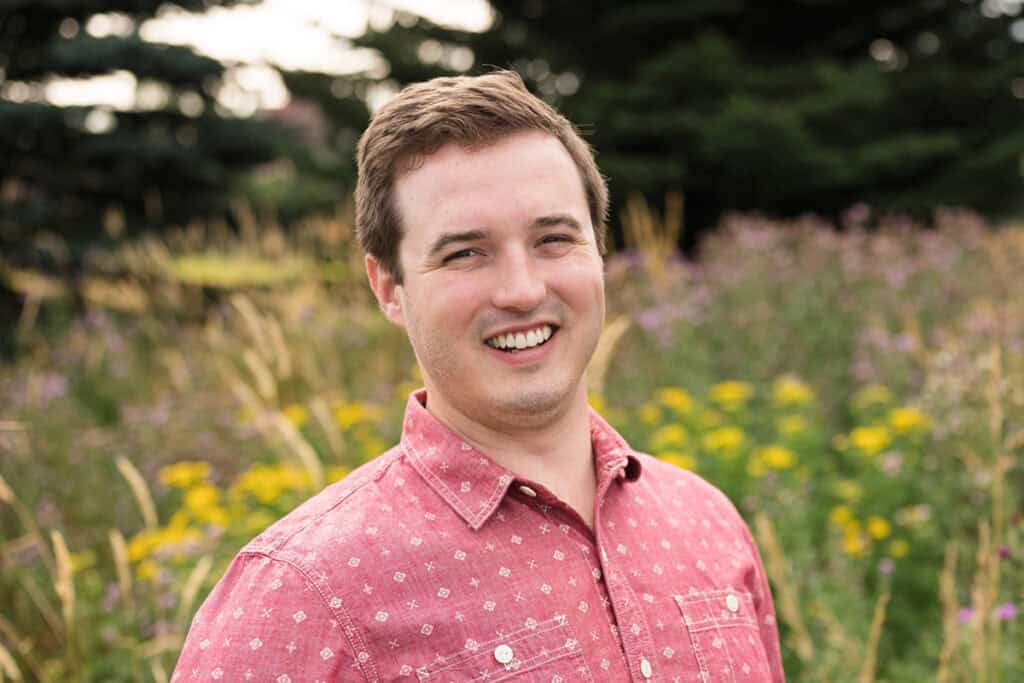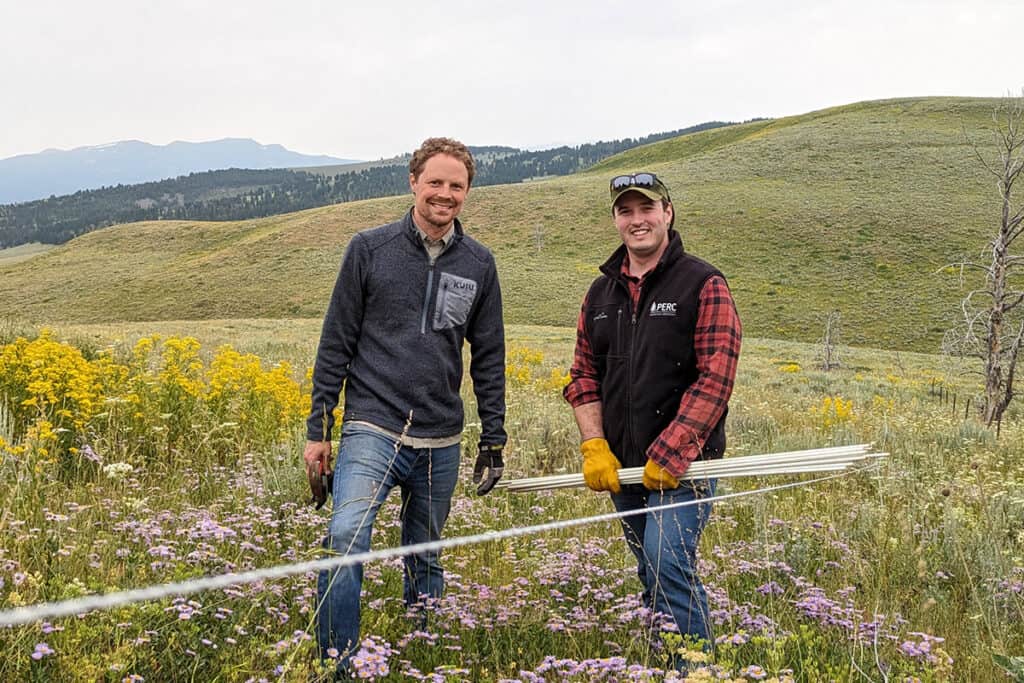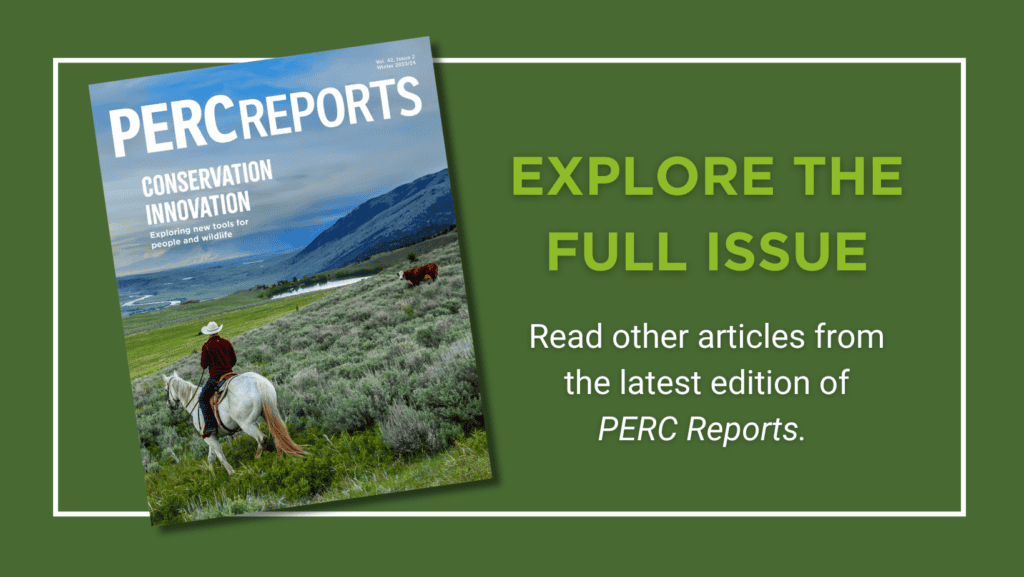
This special issue of PERC Reports features several pilot projects from PERC’s Conservation Innovation Lab. Read the full issue.
Travis Brammer joined PERC as Director of Conservation in 2023, overseeing PERC’s Conservation Innovation Lab and all field projects. Raised as a seventh-generation family cattle rancher in Colorado with professional expertise in western conservation issues, Travis is passionate about the intersection of conservation and agriculture. Spend any amount of time with Travis and it’s clear he brings enthusiasm, energy, and fresh ideas grounded in traditional agricultural values, as well as a respect for those living with the land.
How did growing up on a ranch shape your passion for wildlife?
I spent all my time outside, enjoying the practice of agriculture and seeing the connection between agriculture and nature. I wanted to find ways to protect it.
Tell us a bit about your career.
After an internship on Wall Street, I knew that I belonged in the West more than the streets of Manhattan, and I started with the Wyoming Stock Growers Land Trust. I was afforded the chance to travel all across Wyoming, touring conserved properties and working with many fantastic landowners who are concerned with the conservation legacy of their land.
After a few years, I entered law school at the University of Wyoming College of Law to pursue a joint degree in law and a master’s in environment and natural resources. There I was president of the Natural Resources Law Club, wrote a Burton Award-winning law review article on conserving migration corridors, partnered with some renowned legal, economic, social, and ecological scholars for a law review article as part of the 150th anniversary of Yellowstone National Park, and wrote a master’s thesis on the means of encouraging more young people to participate in agriculture through conservation.
After graduating from law school, I took a position as a Conservation Fellow with the University of Wyoming’s Ruckelshaus Institute of Environment and Natural Resources, where I had the opportunity to work on the NRCS’s Agricultural Conservation Easement Program and state policies to protect migration corridors. I was invited to a PERC workshop on the role of private lands in the future of conservation. After meeting the PERC staff and learning about the exciting work of the organization, I knew I had to find ways to stay involved.
What made you want to join PERC?
For years I saw farmers and ranchers forced to choose between conservation or financial stability. PERC’s pragmatic approach to ensuring that conservation tools are not only ecologically but also economically viable really spoke to me. I also appreciated that all of PERC’s work is founded on robust and well thought-out research, something I saw the importance of firsthand while working for the University of Wyoming.

What makes the Conservation Innovation Lab different from other approaches?
The lab is a bridge builder between conservation organizations and the agricultural community, and between the research community and conservation field. I can’t think of any other organizations that have a foot in all three worlds to create significant, lasting, and well-reasoned conservation solutions.
Ranchers and environmentalists have an adversarial relationship toward one another. How can the lab bridge this divide?
Ranchers often see environmentalists as disconnected from issues on the ground, and only able or willing to take something from the agricultural community. Environmentalists, on the other hand, often see ranchers as harming natural resources and not caring about anything other than bottom lines. By showing ranchers that the environmental community is willing to spend resources on issues that can benefit agricultural operations, and helping the environmental community understand the critical conservation role that ranchers provide, we can help both groups to see eye to eye and benefit one another.
What does a typical day look like?
Part of the beauty of this job is that no two days look the same. I spend time working on identifying and connecting with partners, thinking through a project’s legal framework, researching conservation issues and innovative solutions, and, of course, implementing the projects themselves. About 30 percent of my time is spent out in the field. My favorite parts are getting to connect with other passionate people and finding ways to address the biggest threats facing our land, water and wildlife.
Initial projects are focused in the Greater Yellowstone Ecosystem. Will you establish projects outside the region?
Yes, we are currently working on several applied projects that would take us outside of the Greater Yellowstone Ecosystem, from the Great Salt Lake, to Florida, to the Coast of California.
Do you have a dream project?
My dream project relates back to my master’s thesis. I would like to find a way to use conservation as a means of encouraging young people to get involved in agriculture. It will require significant commitments from a number of critical stakeholders, but the loss of young people to the industry is a critical threat. These are tomorrow’s conservation heroes.
What should a rancher or conservation organization do if they are interested in exploring a potential project?
Feel free to call me. I am always happy to talk to anyone interested in exploring incentive-based solutions to conservation issues.



